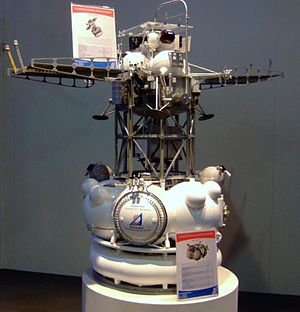
Back فوبوس جرانت Arabic Фобос-грунт Bulgarian ফোবোস-গ্রুন্ত Bengali/Bangla Phobos-Grunt BS Fobos-Grunt Catalan Fobos-Grunt Czech Phobos-Grunt German Fobos-Grunt Esperanto Fobos-Grunt Spanish Fobos-Grunt Finnish
 Model of Fobos-Grunt spacecraft at the 2011 Paris Air Show | |||||||||||||||||||||||||||||||||||
| Names | Phobos-Grunt Фобос-Грунт Phobos-Ground | ||||||||||||||||||||||||||||||||||
|---|---|---|---|---|---|---|---|---|---|---|---|---|---|---|---|---|---|---|---|---|---|---|---|---|---|---|---|---|---|---|---|---|---|---|---|
| Mission type | Phobos lander Sample return | ||||||||||||||||||||||||||||||||||
| Operator | Roscosmos | ||||||||||||||||||||||||||||||||||
| COSPAR ID | 2011-065A | ||||||||||||||||||||||||||||||||||
| SATCAT no. | 37872 | ||||||||||||||||||||||||||||||||||
| Mission duration | 3 years (planned) Failed in Earth orbit | ||||||||||||||||||||||||||||||||||
| Spacecraft properties | |||||||||||||||||||||||||||||||||||
| Manufacturer | Lavochkin, Russian Space Research Institute | ||||||||||||||||||||||||||||||||||
| Launch mass | 13,505 kg (29,773 lb) [1] | ||||||||||||||||||||||||||||||||||
| Dry mass | 2,300 kg (5,100 lb) | ||||||||||||||||||||||||||||||||||
| Power | 1 kW (main orbiter/lander) + 300 W (Earth return vehicle) [2] | ||||||||||||||||||||||||||||||||||
| Start of mission | |||||||||||||||||||||||||||||||||||
| Launch date | 8 November 2011, 20:16:02 UTC | ||||||||||||||||||||||||||||||||||
| Rocket | Zenit-2SB41 | ||||||||||||||||||||||||||||||||||
| Launch site | Baikonur Cosmodrome, Site 45/1 | ||||||||||||||||||||||||||||||||||
| Contractor | Yuzhmash | ||||||||||||||||||||||||||||||||||
| Entered service | Failed on orbit | ||||||||||||||||||||||||||||||||||
| End of mission | |||||||||||||||||||||||||||||||||||
| Last contact | 24 November 2011 | ||||||||||||||||||||||||||||||||||
| Decay date | 15 January 2012, 17:46 UTC [3] | ||||||||||||||||||||||||||||||||||
| Orbital parameters | |||||||||||||||||||||||||||||||||||
| Reference system | Geocentric orbit[3] | ||||||||||||||||||||||||||||||||||
| Regime | Low Earth orbit | ||||||||||||||||||||||||||||||||||
| Perigee altitude | 207 km (129 mi) | ||||||||||||||||||||||||||||||||||
| Apogee altitude | 342 km (213 mi) | ||||||||||||||||||||||||||||||||||
| Inclination | 51.43° | ||||||||||||||||||||||||||||||||||
| Period | 90.0 minutes | ||||||||||||||||||||||||||||||||||
| |||||||||||||||||||||||||||||||||||
Fobos-Grunt or Phobos-Grunt (Russian: Фобос-Грунт, where грунт refers to the ground in the narrow geological meaning of any type of soil or rock exposed on the surface) was an attempted Russian sample return mission to Phobos, one of the moons of Mars. Fobos-Grunt also carried the Chinese Mars orbiter Yinghuo-1 and the tiny Living Interplanetary Flight Experiment funded by the Planetary Society.[4][5]
It was launched on 8 November 2011, at 20:16 UTC, from the Baikonur Cosmodrome, but subsequent rocket burns intended to set the craft on a course for Mars failed, leaving it stranded in low Earth orbit.[6][7] Efforts to reactivate the craft were unsuccessful, and it fell back to Earth in an uncontrolled re-entry on 15 January 2012, over the Pacific Ocean, west of Chile.[8][9][10] The return vehicle was to have returned to Earth in August 2014, carrying up to 200 g (7.1 oz) of soil from Phobos.
Funded by the Russian Federal Space Agency and developed by Lavochkin and the Russian Space Research Institute, Fobos-Grunt was the first Russian-led interplanetary mission since the failed Mars 96. The last successful interplanetary missions were the Soviet Vega 2 in 1985–1986, and the partially successful Phobos 2 in 1988–1989.[11] Fobos-Grunt was designed to become the first spacecraft to return a macroscopic sample from an extraterrestrial body since Luna 24 in 1976.[12]
- ^ Cite error: The named reference
laspace_fobos_grunt_sent_to_baikonurwas invoked but never defined (see the help page). - ^ "Конструкция АМС "Фобос-Грунт"". galspace.spb.ru. Retrieved 1 July 2018.
- ^ a b Vítek, Antonín (25 January 2012). "2011-065A – Fobos-Grunt". Space 40 (in Czech). Retrieved 9 September 2018.
- ^ Amos, Jonathan (9 November 2011). "Phobos-Grunt Mars probe loses its way just after launch". BBC News.
- ^ Lakdawalla, Emily (16 December 2012). Phobos-Grunt is no more. Planetary Society. Archived from the original on 19 January 2012.
- ^ Molczan, Ted (9 November 2011). "Phobos-Grunt – serious problem reported". SeeSat-L. Retrieved 9 November 2011.
- ^ Cite error: The named reference
vladwas invoked but never defined (see the help page). - ^ "Russia's failed Phobos-Grunt space probe heads to Earth", BBC News, 14 January 2012
- ^ "Russian space probe crashes into Pacific Ocean". Fox News Channel. 15 January 2012. Archived from the original on 15 January 2012.
- ^ "Russia asks if US radar ruined Phobos-Grunt space probe", NBC News, 17 January 2012
- ^ "Jonathan's Space Report No.650 2011 November 16". Archived from the original on 9 September 2012.
- ^ "Daring Russian Sample Return mission to Martian Moon Phobos aims for November Liftoff". Universe Today. 13 October 2011.